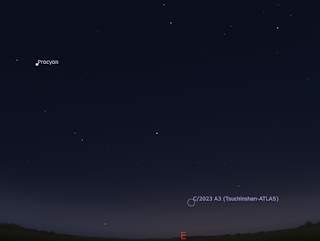Tuesday, September 17, 2024
Thursday September 19 to Thursday September 26
The Last Quarter Moon is Wednesday, September 25. Earth is at equinox on the 22nd. Saturn is just past opposition, and is visible all night long. Venus draws away from the bright star Spica. Mars and Jupiter continue to draw apart as Mars passes through Gemini. The waning Moon is close to Jupiter on the 24th then Mars on the 26th. Comet C/2023 A3 may be seen low in the morning twilight.
The Last Quarter Moon is Wednesday, September 25. Earth is at equinox on the 22nd.
Venus is readily visible now and is now visible when the sky is fully dark. Venus is now moving away from the bright star Spica (alpha Virginis). The inset is the telescopic view of Venus at this time.
Similar views will be seen from the rest of Australia at the equivalent local time (90 minutes after sunset).
Elsewhere in Australia will see a similar view at the equivalent time (90 minutes after sunset).
Mercury is lost in the twilight.
Venus climbs higher in the evening twilight and is readily visible in the evening twilight. Venus draws away from the bright star Spica.
Mars is rising in the morning sky and near Jupiter. The pair continue to draw apart as as Mars enters Gemini. The waning Moon is close to Mars on the 26th.
Jupiter is rising in the the morning twilight sky. Jupiter is below the red star Aldebaran. The waning Moon is close to Jupiter on the 24th.
Saturn climbs higher in the late evening sky. Saturn is visible all night long.
Star Map via Virtual sky. Use your mouse to scroll around and press 8 when your pointer is in the map to set to the current time.
Cloud cover predictions can be found at SkippySky.
Here is the near-real time satellite view of the clouds (day and night) http://satview.bom.gov.au/
Labels: weekly sky








 Click to read about or order
Click to read about or order Click to read about or order
Click to read about or order Click to read about or order
Click to read about or order Click to read about or order
Click to read about or order




